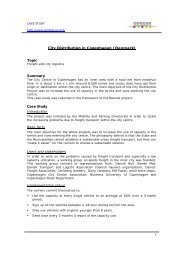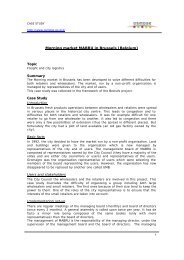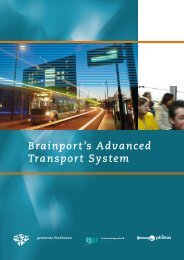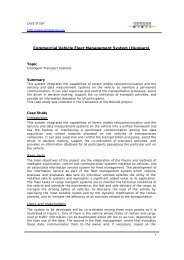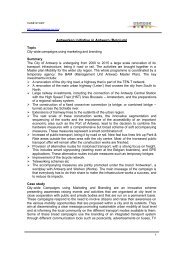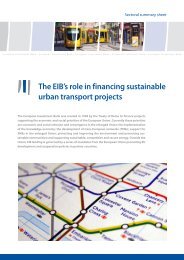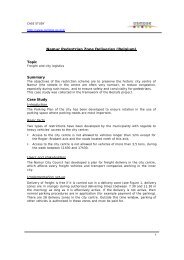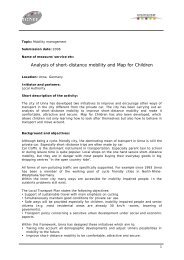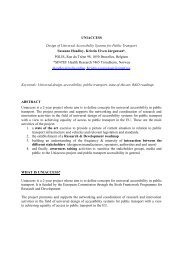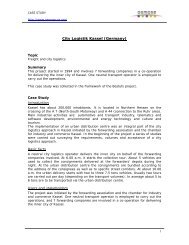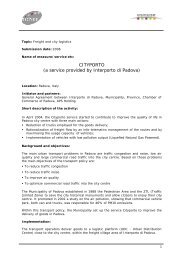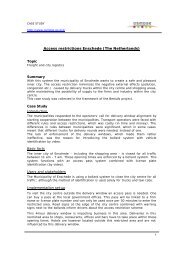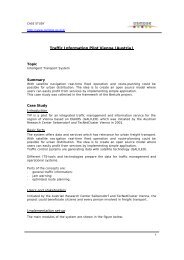Successful transport decision-making - Osmose
Successful transport decision-making - Osmose
Successful transport decision-making - Osmose
Create successful ePaper yourself
Turn your PDF publications into a flip-book with our unique Google optimized e-Paper software.
T10: Project monitoring<br />
Vol 1 - Table of Contents <br />
Next<br />
How to monitor projects<br />
Project monitoring involves the collection and collation of<br />
information needed to assess whether the project is meeting its<br />
objectives at each stage, within agreed resource constraints. It<br />
is central to good project management, as it provides the<br />
means of ensuring that the project is running to budget,<br />
delivering outputs on schedule and meeting various<br />
stakeholder expectations. As such, it should be built in from the<br />
start, as a continuous activity.<br />
The key elements of project monitoring comprise:<br />
Measuring indicators <br />
Tracking progress <br />
Data collection and data storage <br />
Outcome monitoring and evaluation are described in tool T11.<br />
Aims<br />
Project monitoring serves the following purposes:<br />
Checking that resources are being consumed as per<br />
budget;<br />
Ensuring that agreed project outputs are being delivered on<br />
time;<br />
Ensuring that stakeholders are being appropriately<br />
involved and that their expectations are being met, where<br />
practical;<br />
Ensuring that the processes of organisation and<br />
engagement are running smoothly;<br />
Alerting the management team to problems that might<br />
trigger an ‘incident management’ response;<br />
Identifying situations that require actions under ‘external<br />
relations’; and<br />
Providing cumulative experience on how to identify and<br />
overcome barriers.<br />
Useful hints<br />
Most information required for project monitoring is being<br />
collected by someone in the team - the key is to identify<br />
sources and ensure collation in a timely manner;<br />
Monitoring reports on inputs, process indicators and<br />
outputs should be requested and reviewed on a regular<br />
basis;<br />
Key stakeholder groups should be kept informed of<br />
progress, and how they might be affected by the next<br />
stages of delivering the project;<br />
Present the information in easy-to-digest formats (e.g.<br />
graphs of performance against expectation) - this will<br />
enable problems to be quickly spotted; and<br />
One member of the team should be assigned responsibility<br />
for project monitoring, and process monitoring should be<br />
carried out on an on-going basis.<br />
In practice<br />
Gävle, Sweden<br />
The three partners funding the project were very interested in<br />
monitoring and influencing the project process. To achieve this a<br />
regular project-report was expected from the project manager.<br />
During implementation, approximately two meetings a year took<br />
place between the three partners involved in the funding of the<br />
project. A separate report for the cycle-group and for the technical<br />
authority was also required. Furthermore short and informal checkups<br />
took place by phone and email.<br />
Göteborg, Sweden<br />
Vision Lundby intended to increase the share of sustainable modes<br />
and be used as a testing field for new 'soft measures' for creating<br />
behavioural change. After finalising the testing of a certain method<br />
the project manager had to prepare a short summary (minutes-like)<br />
of the tested method. For the meetings between the project<br />
manager and external partners minutes were drawn up. Overall the<br />
monitoring of the process was quite informal as the project was<br />
easily comprehensible and the partners trusted each other.<br />
Graz, Austria<br />
The preparation and introduction of the city-wide 30/50 kph scheme<br />
was accompanied by extensive analyses which had two main<br />
objectives:<br />
<br />
<br />
To be well prepared for an anticipated lawsuit; and<br />
To develop logical and convincing arguments for the institutional<br />
and public marketing campaign.<br />
External experts carried out the analysis which included technical<br />
issues (average speed, exhaust emissions, noise emissions and<br />
social acceptance, etc.) - investigated before and after introduction<br />
of the scheme. This analysis could also be used to evaluate the<br />
success of the project.<br />
The first stage delivered prognoses gained from measuring trips and<br />
theoretical models and provided arguments for the discussion. A<br />
scientific confirmation of the significant benefits of the scheme was<br />
drawn from the analyses after introduction and contributed to the<br />
rapid increase in acceptance for the scheme from the public.<br />
58



